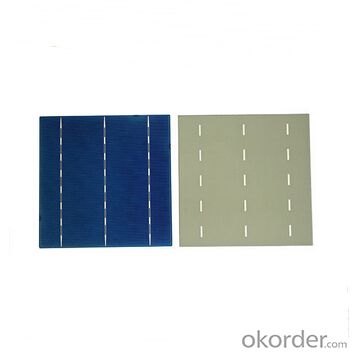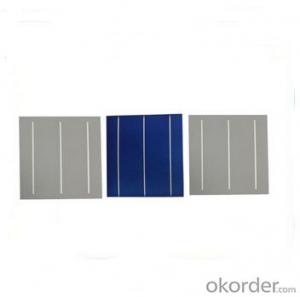Polycrystalline Solar Cell High Quality 156mm×156mm±0.5mm
- Loading Port:
- Shanghai
- Payment Terms:
- TT OR LC
- Min Order Qty:
- 1000 pc
- Supply Capability:
- 1000000 pc/month
OKorder Service Pledge
OKorder Financial Service
You Might Also Like
Solar Cells:
solar cells, when struck by photons of light from the sun, generates an electrical current which can then be used to power DC or AC electrical loads.
A solar cell is made of silicon. Computer chips are made of this same material. Basically, when light strikes the surface of a solar cell some of it is absorbed into the silicon. This light energy bumps the electrons loose and causes energy to flow
Solar cells is made by solar wafer, it has three categories of solar cell right now, monocrystalline polycrystalline and thin film,These cells are entirely based around the concept of PN junction, which is the critical part of solar module, it is the part that can convert the light energy into electricity, the thickness is from 180um to 200um, with even busbars to conduct electricity, textured cell can decrease diffuse reflection; they are often electrically connected and encapsulated as a module. Photovoltaic modules often have a sheet of glass on the front (sun up) side, allowing light to pass while protecting semiconductor wafers from abrasion and impact due to wind-driven debris, rain, hail, etc. Solar cells are also usually connected in series in modules, creating an additive voltage. Connecting cells in parallel will yield a higher current;With high quality and stable quality. Our Cells can greatly improve the performance of Solar Modules.
Specifications
Format | 156mm×156mm±0.5mm |
Thickness | 210μm±30μm |
Front(-) | 1.4mm bus bars(silver), blue anti-reeecting coating(silicon nitride) |
Back(+) | 2.0mm wide soldering pads(silver) back surface eld(aluminum) |
Efficiency(%) | Pmpp(W) | Umpp(V) | Impp(A) | Uoc(V) | Isc(A) | FF(%) |
17.80-18.00 | 4.33 | 0.53 | 8.159 | 0.633 | 8.709 | 78.44 |
17.60-17.80 | 4.29 | 0.527 | 8.126 | 0.631 | 8.677 | 78.27 |
17.40-17.60 | 4.24 | 0.524 | 8.081 | 0.628 | 8.629 | 78.17 |
17.20-17.40 | 4.19 | 0.521 | 8.035 | 0.625 | 8.578 | 78.08 |
17.00-17.20 | 4.14 | 0.518 | 7.99 | 0.623 | 8.531 | 77.97 |
Features:
High efficiencies up to 16.4%
Proven long term mechanical stability of silicone
Make of highly purified poly silicone
Three bus bars for reduced series resistance and improved module and cell efficiency
Blue anti-reflecting coating ensures improved light absorption and increased efficiency
Acid texturization offers a uniform appearance and virtually invisible crystal structure
Excellent low light behavior for improved energy yield
Solar Cells Advantage:
• High efficiency and stable performance in photovoltaic conversion.
• Advanced diffusion technique ensuring the homogeneity of energy conversion efficiency of the cell.
• Advanced PECVD film forming, providing a dark blue silicon nitride anti-reflection film of homogenous color and attractive appearance.
• High quality metal paste for back surface and electrode, ensuring good conductivity, high pulling strength and ease of soldering.
• High precision patterning using screen printing, ensuring accurate busbar location for ease with automatic soldering a laser cutting.

FAQ
We have organized several common questions for our clients,may help you sincerely:
①What price for each watt?
It depends on the efficiency of the solar cell, quantity, delivery date and payment terms.
②How long can we receive the product after purchase?
In the purchase of product within three working days, We will arrange the factory delivery as soon as possible. The pecific time of receiving is related to the state and position of customers.Commonly 7 to 10 working days can be served.
③Can you provide the peripheral products of the solar panels, such as the battery, controller, and inverter? If so, can you tell me how do they match each other?
Yes, we can, we have two companies for solar region, one is CNBM International, the other is CNBM engineering Co.
We can provide you not only the solar module but also the off grid solar system, we can also provide you service with on grid plant.
④What is your warranty of solar cell?
Our product can promise lower than 0.3% open box crack, we support claim after opening the box if it has crackm color difference or sth, the buyer should give pictures immediately, we can not accept the claim after the solar cell has assembled to solar panel.
• Timeliness of delivery
• ⑤How do you pack your products?
We have rich experience on how to pack the solar cell to make sure the safety on shipment, we could use wooden box or pallet as buyer's preference.
- Q:Can solar cells be used for powering wildlife tracking devices?
- Yes, solar cells can be used for powering wildlife tracking devices. Solar cells are a reliable and sustainable source of energy that can effectively power small electronic devices, including wildlife tracking devices. They can harness sunlight and convert it into electrical energy, providing a continuous power supply for tracking devices in remote locations where other power sources may be limited or unavailable.
- Q:Can solar cells be used for powering remote research stations in Antarctica?
- Yes, solar cells can be used for powering remote research stations in Antarctica. They provide a reliable and sustainable source of energy in a region where sunlight is available for a significant portion of the year. Solar panels can be installed to capture sunlight and convert it into electricity, allowing for the operation of essential equipment and facilities in these remote locations without relying on traditional fossil fuel-based generators.
- Q:How to get high voltage, high current output of solar cells
- Series can increase the output voltage, parallel can provide output current. Using a series parallel method to achieve, for example: need 220 volts 10 amps.
- Q:How long does it take to install solar cells on a rooftop?
- The installation time for solar cells on a rooftop can vary depending on various factors such as the size of the system, complexity of the installation, and the experience of the installation team. However, on average, a typical residential installation can take anywhere from one to three days.
- Q:How do solar cells perform in dry desert conditions?
- Solar cells perform exceptionally well in dry desert conditions. The intense sunlight and lack of moisture in deserts create ideal conditions for solar energy generation. The absence of clouds and high temperatures enhance the efficiency of solar cells, allowing them to produce more electricity. Additionally, the dry conditions minimize the risk of corrosion and dust accumulation, which can further improve the performance and lifespan of solar panels.
- Q:Where can I buy solar cells on sale but still good quality ?
- Sometimes you can find a good deal with the local manufacturers, where they sell some good quality solar cells at a pretty good price.
- Q:How do solar cells perform in desert environments?
- Solar cells perform exceptionally well in desert environments due to the abundance of sunlight and high temperatures. The vast open spaces and lack of cloud cover allow solar panels to receive maximum exposure to sunlight, resulting in higher energy production. Additionally, the dry and arid conditions in deserts help reduce dust and dirt accumulation on panels, ensuring optimal performance and efficiency.
- Q:How do solar cells convert sunlight into electricity?
- Solar cells convert sunlight into electricity through a process called the photovoltaic effect. When sunlight hits the solar cell, the photons from the sunlight energize the electrons in the cell's semiconductor material, causing them to break free from their atoms. This creates an electric current, which can then be harnessed and used as electricity.
- Q:How do solar cells perform in areas with high levels of insect activity?
- Solar cells can be affected by insects in areas with high levels of insect activity. Insects can cause shading on the surface of solar panels, reducing their efficiency. Additionally, insect debris and waste can accumulate on the panels, further decreasing their performance. Regular cleaning and maintenance can help mitigate these issues and ensure optimal performance of solar cells in such areas.
- Q:Can solar cells be used for large-scale power generation?
- Yes, solar cells can certainly be used for large-scale power generation. They have the potential to harness abundant sunlight and convert it into electricity on a massive scale. As technology and efficiency of solar cells continue to improve, they are increasingly being deployed in utility-scale solar farms, providing a sustainable and renewable source of power to meet the growing energy demands of our society.
1. Manufacturer Overview |
|
|---|---|
| Location | |
| Year Established | |
| Annual Output Value | |
| Main Markets | |
| Company Certifications | |
2. Manufacturer Certificates |
|
|---|---|
| a) Certification Name | |
| Range | |
| Reference | |
| Validity Period | |
3. Manufacturer Capability |
|
|---|---|
| a)Trade Capacity | |
| Nearest Port | |
| Export Percentage | |
| No.of Employees in Trade Department | |
| Language Spoken: | |
| b)Factory Information | |
| Factory Size: | |
| No. of Production Lines | |
| Contract Manufacturing | |
| Product Price Range | |
Send your message to us
Polycrystalline Solar Cell High Quality 156mm×156mm±0.5mm
- Loading Port:
- Shanghai
- Payment Terms:
- TT OR LC
- Min Order Qty:
- 1000 pc
- Supply Capability:
- 1000000 pc/month
OKorder Service Pledge
OKorder Financial Service
Similar products
New products
Hot products
Related keywords



























